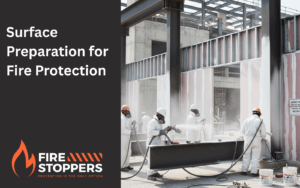Here’s something most building owners don’t realise until it’s too late: you can buy the most expensive intumescent coating on the market, get it installed by certified professionals, tick all the compliance boxes—and still end up with fire protection that fails when you need it most.
The reason? The surface underneath wasn’t properly prepared.
At Firestoppers, we’ve walked into buildings where previous contractors skipped surface preparation steps to save time. The coating looked fine. The paperwork was perfect. But when we tested adhesion, sections came off with barely any effort. That’s not fire protection—that’s an expensive liability waiting to happen.
Why Surface Preparation Is the Foundation of Fire Safety
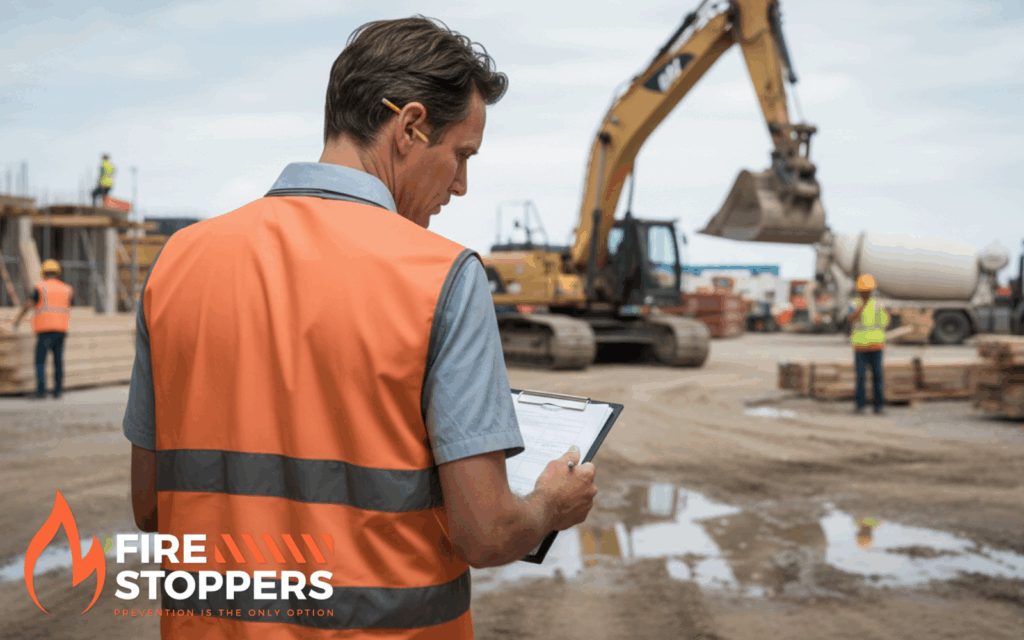
Think about painting over a dirty, greasy wall. You know exactly what happens—the paint bubbles, peels, and fails within months. Fire-resistant coatings work the same way, except the consequences are catastrophically worse.
When structural steel comes from the mill or sits on a construction site, it’s covered in contaminants. Mill scale from manufacturing. Oil and grease from handling. Dust from grinding. Corrosion from condensation and moisture. Every single one of these creates a barrier between your coating and the steel substrate.
Proper surface preparation removes these obstacles completely. It creates the clean, slightly roughened surface that allows fire protection coatings to form a mechanical bond with the steel surface. Not just sitting on top—actually bonded at a molecular level.
This matters because during a fire event, that coating needs to expand and create a protective barrier that stops heat transfer to the substrate beneath. If the coating delaminates from the steel surface because of poor adhesion, your 90-minute fire resistance rating becomes meaningless. The structural steel heats up, loses strength, and your building’s structural integrity is compromised.
Surface Preparation Methods for Gypsum Fire Board and Steel Surfaces
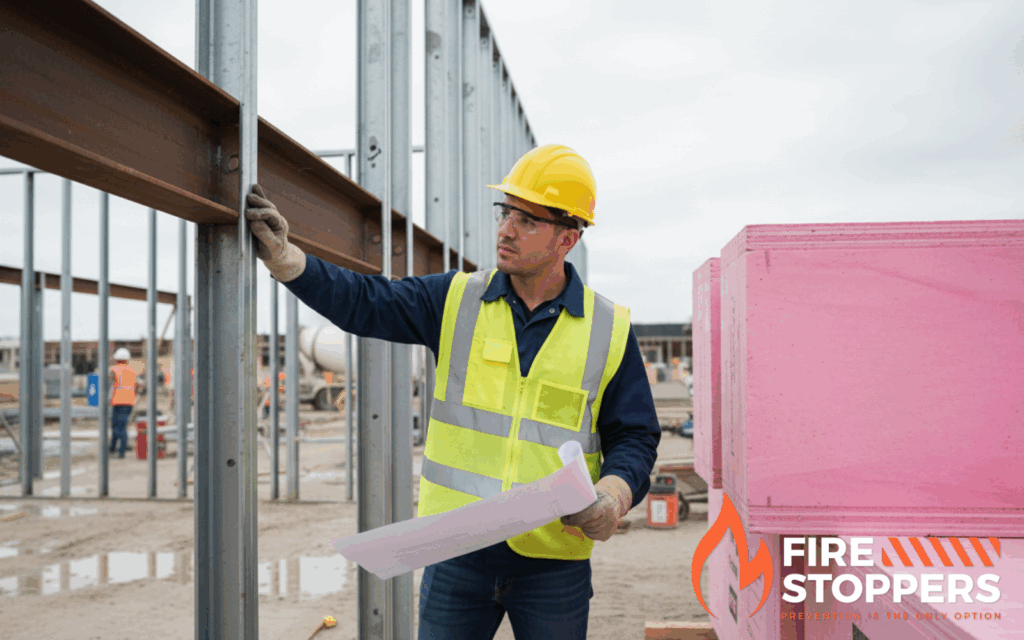
Different construction materials require different surface preparation approaches. Whether you’re working with steel structures, gypsum fire board systems, or composite materials, proper surface preparation is essential for effective fire protection.
Preparing Steel Surfaces for Fire-Resistant Coatings
Steel surface preparation involves removing mill scale, corrosion, and any contaminant that could compromise adhesion. The goal is to create a clean substrate with the right surface profile—not too smooth, which prevents mechanical bond formation, and not too rough, which can affect coating thickness.
For structural steel members in steel construction projects, we use abrasive blasting or mechanical preparation methods depending on the steel surface condition and environmental conditions. The substrate must achieve the surface cleanliness level specified in the manufacturer’s recommendations before any prime coat or coating system can be applied.
Proper cure time between surface preparation and coating application is critical. Apply coating too soon after preparation, and condensation or relative humidity issues can compromise adhesion. Wait too long, and flash corrosion can form on the clean steel surface, requiring re-preparation.
Gypsum Board Surface Preparation for Fire Prevention
Fire board and gypsum-based fire protection systems also require proper surface preparation, though the methods differ from steel. Gypsum surfaces must be clean, dry, and free from dust or loose material that could prevent adhesion of protective coatings or fire-stopping materials.
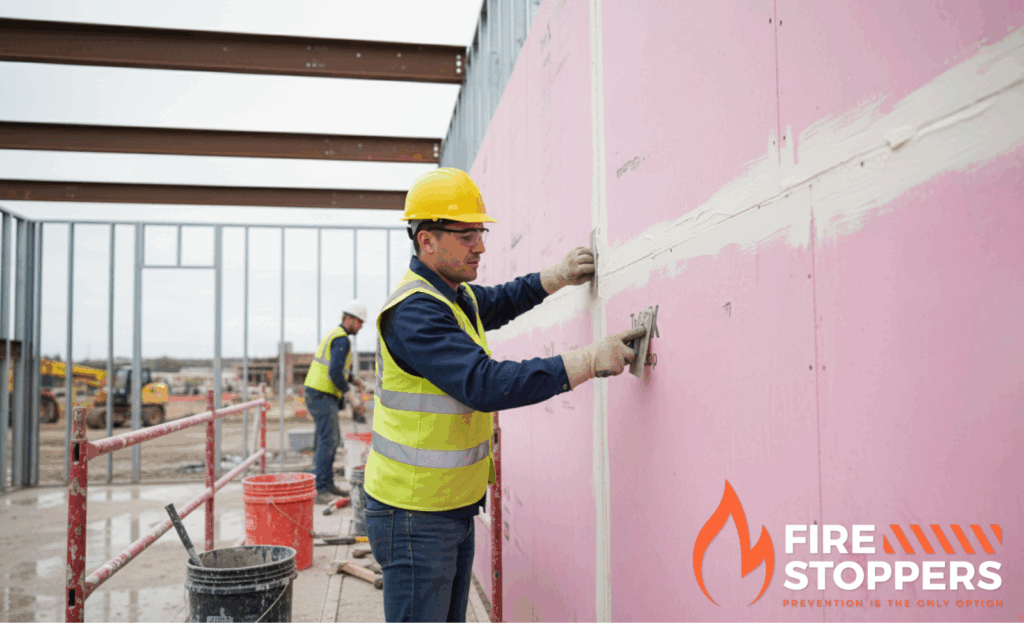
When working with walls and ceilings constructed from gypsum fire-resistant boards, we ensure the substrate is properly sealed and primed. This prevents the gypsum from absorbing moisture from coating systems and ensures uniform adhesion across the entire surface. The low thermal conductivity of gypsum makes it excellent for fire prevention, but only when properly prepared and sealed.
Many fire protection strategies combine gypsum systems with intumescent coatings on structural steel to create comprehensive passive fire protection systems that compartmentalise buildings and limit the spread of fire.
How Proper Surface Preparation Ensures Fire Resistance Ratings
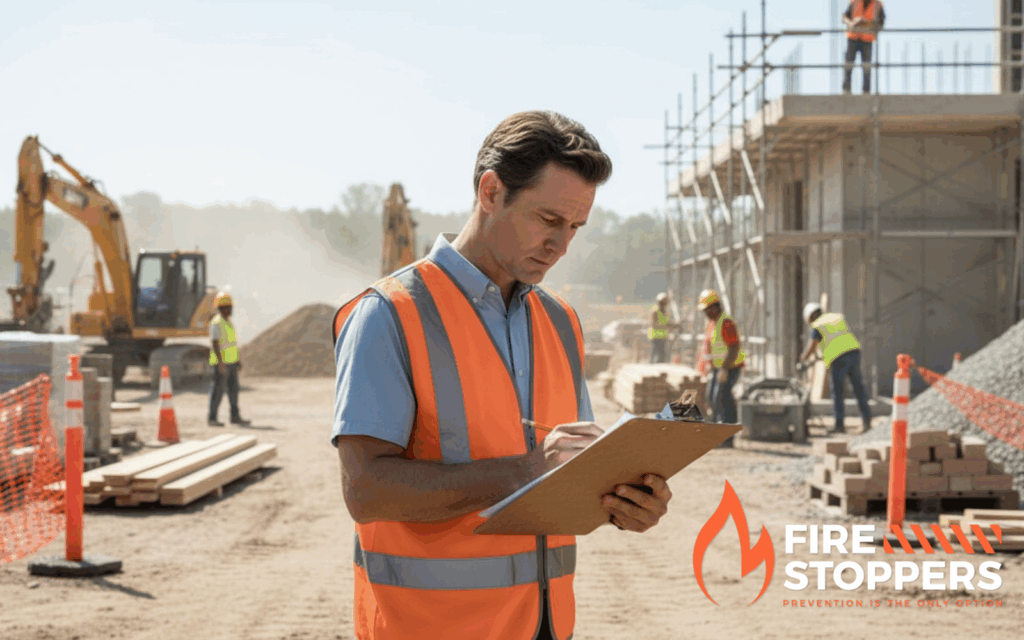
Here’s what most people don’t understand about fire resistance ratings: those 60, 90, or 120-minute certifications aren’t just about the coating itself. They’re about the entire coating system—applied exactly according to the manufacturer’s recommendations, including surface preparation.
When testing labs certify intumescent coatings, they apply them to properly prepared substrates under controlled conditions. They verify the coating thickness, cure time, and environmental conditions. Everything is done according to standard practices.
But on actual job sites? We’ve seen contractors rush surface preparation to meet deadlines. Apply coating to surfaces that are too smooth for a proper mechanical bond. Ignore relative humidity requirements. Skip the primer coat. Every single shortcut compromises the fire protection system’s ability to withstand high temperatures and perform during fire exposure.
The Science Behind Coating Adhesion and Fire Resistance
Fire-resistant coatings work through multiple mechanisms. Intumescent coatings expand during combustion, creating an insulating char layer. Silicate-based systems provide non-combustible protection. Cementitious fireproofing uses additives and low thermal conductivity materials to slow heat transfer.
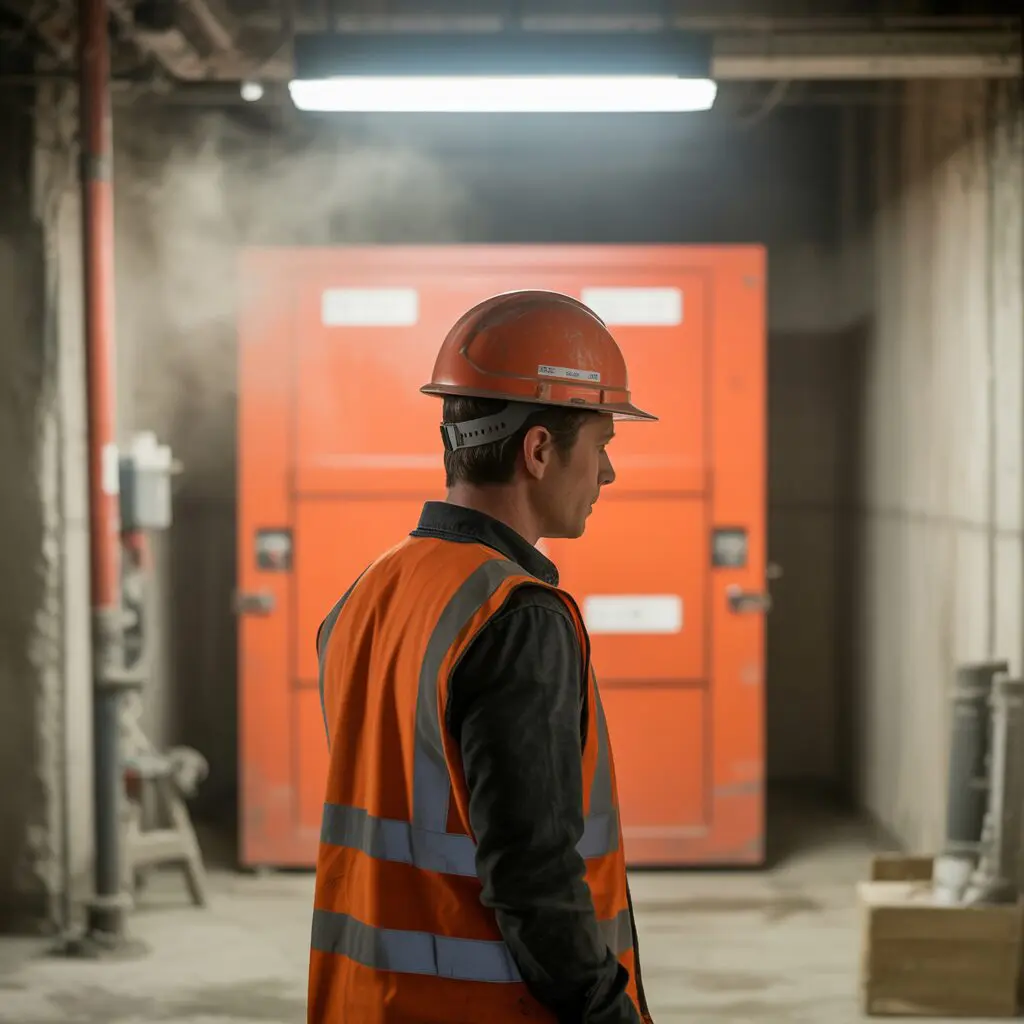
But regardless of the coating type, adhesion to the substrate is what makes everything work. Poor adhesion means the coating can’t stay in place during fire conditions. It can’t expand properly. It can’t protect steel from high fire temperatures or prevent structural members from losing strength.
Ensure proper adhesion through correct surface preparation, and your fire protection systems perform exactly as certified. Skip surface preparation steps, and even the best fire-resistant coating becomes ineffective.
Surface Preparation Protects Your Investment in Fire Safety
Proper surface preparation isn’t just about immediate performance. It’s about long-term performance and structural safety over the building’s entire lifetime in industrial facilities, critical infrastructure, and commercial buildings.
When you prepare the substrate correctly, you create a durable surface that resists environmental conditions. The coating system maintains its protective properties through temperature changes, humidity fluctuations, and normal building use. You get decades of reliable fire prevention without premature coating failure or costly reapplication.
We’ve inspected steel structures where proper surface preparation was done 15-20 years ago. The coating still shows excellent adhesion. Still provides the rated fire protection. It still does exactly what it was designed to do.
Compare that to poorly prepared surfaces, where coating failure starts within just a few years. Sections begin to delaminate. Corrosion creeps underneath. Eventually, you’re looking at complete removal and reapplication—at several times the cost of doing it properly the first time.
For protecting structural elements in steel construction, where steel members must maintain structural integrity during fire exposure, cutting corners on surface preparation is a false economy that always costs more in the end.
Fire Prevention Starts With Surface Preparation Standards

Effective fire protection strategies require following industry standard practices for surface preparation. This isn’t optional or subject to interpretation—it’s the foundation of fire safety in buildings.
We follow specific surface preparation methods based on the substrate type, coating system requirements, and installation conditions. For structural steel, this typically means achieving a defined surface cleanliness level and profile depth. For gypsum and fire board systems, it means proper cleaning, sealing, and priming to prevent moisture issues that compromise adhesion.
Before applying any fire-resistant coating, we verify that:
- Surface cleanliness meets the manufacturer’s recommendations
- Environmental conditions, including temperature and relative humidity, are within specification
- The substrate is free from any contaminant, including solvents, oils, or loose material
- Proper cure time will be available before the coating is exposed to traffic or weather
- The surface profile supports the mechanical bond needed for long-term adhesion
These checks take time, but they’re what separates fire protection systems that work from expensive failures that put occupants at fire risk.
How Firestoppers Approaches Fire Protection and Surface Preparation
At Firestoppers, surface preparation isn’t a step we rush through to get to the “real work” of coating application. It is the real work, because without it, nothing else matters.
Our Surface Preparation Process

We start by assessing the existing conditions—what contaminants are present on the steel surface, whether there’s existing corrosion, what the environmental conditions are, including relative humidity and temperature. This assessment determines exactly which surface preparation methods we need to use.
Then we remove everything that could compromise adhesion. Not just obvious dirt and grease, but mill scale, old coatings, and any contaminant that creates a barrier between the substrate and the new coating system. We create the proper surface profile that gives the coating something to grip onto for a strong mechanical bond.
For steel construction projects, we typically use abrasive blasting to achieve the required surface cleanliness and profile. For gypsum fire board or existing coating systems, we use appropriate mechanical or chemical surface preparation methods that won’t damage the underlying substrate.
Working With Different Fire Protection Systems
Whether we’re installing intumescent coatings on structural steel, applying fire-resistant boards to walls and ceilings, or implementing fire-stopping systems to compartmentalise buildings and prevent the spread of fire, our commitment to proper surface preparation remains constant. For intumescent fireproofing systems, we ensure the steel surface is prepared to accept the coating and allow it to expand properly during fire conditions
The adhesion must be strong enough that the expanding char layer stays attached to the structural steel even under high fire temperatures and the stress of combustion.
For gypsum-based passive fire protection systems, we prepare surfaces to accept fire board installation with proper adhesion of mastics, ensure joints are properly sealed for fire stopping, and verify that the entire system will maintain its non-combustible properties and low thermal conductivity during fire exposure.
Quality Verification Before Coating Application
Before we apply any coating, we verify surface preparation quality through adhesion testing, visual inspection of surface cleanliness, and confirmation that environmental conditions meet specifications. We document everything because proper surface preparation is too important to leave to chance.
We also ensure adequate cure time between preparation and coating application, and between coating layers. Rushing cure time to meet deadlines compromises adhesion and long-term performance—something we never do.
The Real-World Difference Surface Preparation Makes

We worked on a steel construction project where another contractor had already applied fire-resistant coatings to structural members. The building owner called us because sections were showing poor adhesion, just months after installation.
When we tested the coating, it came off easily. The steel surface underneath still had mill scale and contamination. The previous contractor had rushed surface preparation to meet their deadline, and now the entire fire protection system was compromised. The coating thickness was correct, the installation looked professional, but without proper adhesion to the substrate, none of it mattered.
We had to remove all the existing coating, properly prepare every steel surface using correct surface preparation methods, and reapply the fire-resistant coating system according to the manufacturer’s recommendations. The building owner paid twice—once for work that failed, and again to have it done properly.
That’s what happens when contractors treat surface preparation as an optional step rather than the foundation of effective fire protection.
What Proper Surface Preparation Means for Fire Safety in Your Building

Your passive fire protection systems exist for one reason: to give occupants time to evacuate safely and maintain structural integrity long enough for fire suppression efforts to work. They’re not just compliance checkboxes. They’re life safety systems that need to perform perfectly during the worst possible scenario.
That performance starts with proper surface preparation. It’s what transforms construction materials into reliable fire prevention. It’s what ensures your fire-resistant boards, intumescent coatings, and other fire protection materials can actually enhance fire resistance when exposed to combustion and high fire conditions.
Long-Term Benefits of Correct Surface Preparation
Proper surface preparation provides multiple benefits beyond immediate fire safety:
Structural Safety: Protect steel structures and steel members from heat transfer during fire events, maintaining structural integrity when it matters most
Cost-Effective Solution: A durable finish that lasts decades without premature failure or expensive remediation
Compliance Confidence: Fire resistance ratings that are real, not theoretical, because coating systems were applied according to standard practices
Performance Assurance: Fire protection systems that will actually withstand high temperatures and function during fire exposure to compartmentalise your building and limit fire damage
When surface preparation is done correctly, every other element of your fire protection strategy works as designed. The coating maintains proper adhesion. The substrate stays protected from corrosion. The entire system delivers its rated fire resistance over the long-term performance period you’re counting on.
Firestoppers: Fire Protection Built on Proper Surface Preparation
At Firestoppers, we understand the pressure to move quickly on construction projects. Deadlines matter. Budgets matter. But fire safety in buildings matters more.
That’s why we never compromise on surface preparation. We follow the manufacturer’s recommendations precisely. We use proven surface preparation methods for each substrate type. We verify surface cleanliness and adhesion before coating application. We ensure proper cure between preparation and coating installation.
Because when a fire event happens, there’s no second chance. Your fire protection systems either work exactly as designed, or they don’t. And that difference starts with how well the surface was prepared before any coating was ever applied.
We work with all types of fire protection materials—from intumescent coatings and silicate systems to gypsum fire board and cementitious fireproofing. Whether your project involves protecting structural steel in industrial facilities, installing fire-resistant boards on walls and ceilings, or implementing fire-stopping systems to prevent the spread of fire, we bring the same commitment to proper surface preparation.
Our approach ensures that your investment in fire safety delivers a cost-effective solution with long-term performance, not an expensive problem that needs fixing in a few years.
Ready to ensure your building has fire protection that will actually perform when it matters most?
Need Fire Safety Services?
Professional fire safety solutions for your peace of mind
Contact FireStoppers Today!
For Fire Emergency: Call 999 or 112
For all other fire safety services, use the contact details above
Contact Firestoppers to discuss your fire protection needs. We’ll show you exactly how proper surface preparation creates the foundation for reliable, long-term fire safety in your building.

